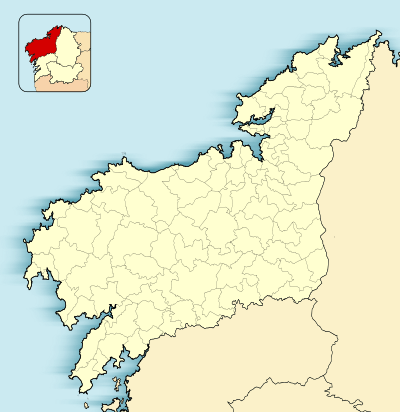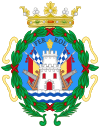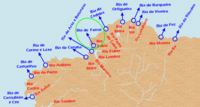Ferrol, Galicia
| Ferrol | |||
|---|---|---|---|
| Municipality | |||
|
Ferrol Port | |||
| |||
 Ferrol  Ferrol Location of Ferrol within Galicia | |||
| Coordinates: 43°28′N 8°15′W / 43.467°N 8.250°WCoordinates: 43°28′N 8°15′W / 43.467°N 8.250°W | |||
| Country | Spain | ||
| Autonomous community | Galicia | ||
| Province | A Coruña | ||
| Comarca | Ferrol | ||
| Fishing Village | 1st century BC | ||
| Christian Outpost | 8th century | ||
| Royal Arsenal | 16th century | ||
| Royal Dockyard | 18th century | ||
| Parishes | Brión, A Cabana, Covas, Doniños, Esmelle, Ferrol, A Graña, Leixa, Mandiá, Marmancón, A Mariña, Trasancos, Serantes | ||
| Government | |||
| • Type | Mayor-council | ||
| • Body | Concello de Ferrol | ||
| • Mayor | José Manuel Rey Varela (PPdeG) | ||
| Area | |||
| • Total | 81.9 km2 (31.6 sq mi) | ||
| Population (2014)INE | |||
| • Total | 70,389 | ||
| Demonym(s) | ferrolan (m), ferrolana (f) | ||
| Time zone | CET (GMT +1) | ||
| • Summer (DST) | CEST (GMT +2) (UTC) | ||
| Postcode | 15401 - 15406 | ||
| Area code(s) | +34 981 | ||
| Website | http://www.ferrol.es/ | ||
Ferrol (Galician pronunciation: [feˈrɔl]), is a city in the Province of A Coruña in Galicia, located on the Atlantic coast in north-western Spain. According to the 2014 census, the city has a population of 70,389 making it the 5th largest settlement in Galicia. With Eume to the south and Ortegal the north, Ferrol forms the Ferrolterra conurbation, the third largest in Galicia which has a total population of over 203,444.
The city has been a major naval shipbuilding centre for most of its history, being the capital of the Spanish Navy's Maritime Department of the North since the time of the early Bourbons. Before that, in the 17th century, Ferrol was the most important arsenal in Europe. Today, the city is also known as the home of the shipbuilding yards of Navantia.
The city was the birthplace of the Spanish General and dictator Francisco Franco in 1892, and was officially known as El Ferrol del Caudillo from 1938 to 1982. It was also the birthplace of the founder of the Spanish Socialist Workers' Party (PSOE), Pablo Iglesias, in 1850.
Toponym and etymology
The first historical mention of this settlement, then called Adobrica, is in the history of Pomponius Mela, a Roman historian who wrote in the year AD 43 detailing a description of the Portus Magnus Artabrorum, the "great port of the Artabri". The current toponym Ferrol, though, can only be traced back to the Middle Ages; a document of 1087 instances sancto Iuliano de Ferrol, where Ferrol is probably the local evolution of the genitive form of the Latin name Ferreolus; Ferrol was probably, in origin, the estate of one Ferreolus.[1] In 1982 the government of Spain adopted officially Ferrol in consonance with its long history and tradition.[2]
Alternately. the origin of the name comes from the legend of a Breton saint, Ferreol, who arrived here on a ship, amid a chorus of seven siren. Another tradition says that Ferrol proceeds from farol, alluding to the heraldic figure that appears on the coat of arms of the city.[3] However, according to experts, the origin of the arms of Ferrol goes back only to the eighteenth century, and there are also several variants used over time, without having been set in accordance with the applicable legislation since the 1990s.[4] The combination of two .words that can mean either 'port - close', 'landing on pillars' or a Ferreoli Domini, "the lord of Ferreol" veiled allusion to the town, which could have had a temple under the patronage of St. Ferreol.
History


The existence of prehistoric human settlements in this Galician city is backed up by the abundance of burial chambers, megalithic monuments as well as Petroglyphs and other archaeological findings. The Phoenicians established in this area different dried and salted cod stations and their presence together with the presence of the Ancient Greeks is well documented by historians like Herodotus amongst others. In Roman times, in the 1st century BC, a fishing port existed in the bay of Ferrol. After the fall of the Western Roman Empire the whole Iberian Peninsula, including Ferrol, was raided by the Vandals and incorporated in 411 to the Suebic Kingdom of Galicia; their kingdom was incorporated in 584 by Leovigild to the Visigothic Kingdom.[5]

Ferrol served as a strategic safe port during the Hundred Years' War, sided the House of Trastamara during the Castilian Civil War and as a personal reward to Fernan Perez de Andrade, in 1371, Henry II gave the town to the powerful Andrade family.[6]
In 1568[7] a fire reduced to rubble the old medieval town; in the same period some parts of the existing fortifications at the entrance of the estuary were built.[8] As a naval base, at that time the town was considered more important as a Royal Arsenal than as a safe harbour.
With the arrival of the Bourbons in the 18th century, Ferrol became a leading naval centre.[9] Ferrol was made Capital of the Maritime Department of the North, formed under Ferdinand VI and Charles III for the defence of the Spanish Colonial Empire in America. Rapid improvements followed, notably under the leadership of the Marquis of Ensenada, and the position of Ferrol was made almost unassailable from the sea, the difficulties of disembarking troops on its precipitous coast being strengthened by a renewed line of fortresses and newly built castles, including that of San Carlos.
The Royal Dockyards of A Graña and Ferrol, built between 1726–1783,[10] produced ships protected with copper sheets from the rolling mills of Xubia. In 1772, The Spanish Royal Academy of Naval Engineers of Ferrol, the first such academy in Spain, was created.
Ferrol was virtually impossible to blockade in the age of sail, as strong westerly winds would take any blockading force away along the treacherous north coast of Spain where they had no safe haven. The geography of Ferrol meant that an entire Spanish fleet could slip out on a single tide. By the time the British were able to resume the blockade, the Spanish would be safely away and out to sea. Despite these advantages, a decline set during the reign of Charles IV, and in 1800, during the Ferrol Expedition (1800), after the defences had been reduced, a British fleet of 109 vessels landed troops on the beach of Doniños to take the Castle of San Felipe. Although only equipped with meagre artillery, the castle's small defence force under the command of Count Donadio together with a sizable number of volunteer citizens of Ferrol, successfully resisted the attack and the fleet withdrew. The alliance with the United Kingdom during the Peninsular War of 1808–14 failed to prevent the deterioration in the town’s fortunes. The arsenals and fortresses were abandoned and they were easily occupied by the French in 1809.

Under Ferdinand VII, Ferrol lost its title of capital. New activities sprang up, however, in the mid-19th century, during the administration of the Marquis de Molina,[11] Spanish Minister for Naval affairs, which included amongst other political successes the construction and launch in the Royal Dockyards of Ferrol of Spain's first steam propelled ship in 1858.
The second half of the 19th century brought to the Royal Dockyards of Ferrol not just plenty of work but social and political tensions which ended up in the failed republican uprising of 1872.[12]
During this period, same as it is nowadays, and just like it was in the days of the Armada, the Bay of Ferrol always attracts numerous ships seeking repairs or refuge after meeting with desaster or rough waters trying to cross the Bay of Biscay on bad weather. Such was the case of the Cleopatra, carrying one of the two Cleopatra Needles, the one standing today on the Thames Embankment in London, UK. It arrived in Ferrol on 19 October 1877 after tragedy and almost sinking off the West coast of France five days earlier. There is a plaque commemorating the event and those who died to be seen at the base of the Needle in London.
For a period of sixteen years, all the technicians were exclusively British, and the situation was not altered till 1925 when the management was taken over by Spanish engineers, as one of the new policies introduced by the then newly created government, including ministers both civil and military, of the dictator Miguel Primo de Rivera (1923–1930). The arrival of the British coincided with the construction of a local electric-powered trolley streetcar's line (1924–1961).[13]
In sight of the outbreak of the Spanish Civil War, and because there was fear of social unrest in the naval station, the Foreign Office in London,[14][15] organized a ship to repatriate all the remaining British citizens and on 22 July 1936 HMS Witch (D89)[16] departed from Ferrol back to Britain. At the outbreak of the Spanish Civil War (1936–1939) the shipbuilding yards, workshops, foundries and dry docks in Ferrol were taken over by the state and fully nationalized in 1945 under the name "Bazán", later renamed "IZAR", and, starting from January 2005, Navantia. The town was the birthplace of dictator Francisco Franco, after whom the city was officially known as El Ferrol del Caudillo from 1938 to 1982. The end of the dictatorship and the arrival of democracy in 1978 did not help Ferrol,[17][18] and from 1982 to the early 1990s, the city confronted numerous problems due to a decline in the naval sector. The beginning of the new millennium however has been a time of economic expansion and prosperity in general.[19] A new motorway and an outer-port[20] have been built.
Ferrol hosted the large NATO Maritime Exercise Loyal Mariner (RN) in June 2008.[21]
Climate
As in most of Galicia, Ferrol climate is a humid oceanic climate, characterised by year-long mild temperatures, rainy winters, and relatively dry summers, although slightly wetter than the typical Spanish mediterranean climate during the summer season.
| Climate data for Ferrol, Galicia (Spain) (2002-2010) | |||||||||||||
|---|---|---|---|---|---|---|---|---|---|---|---|---|---|
| Month | Jan | Feb | Mar | Apr | May | Jun | Jul | Aug | Sep | Oct | Nov | Dec | Year |
| Average high °C (°F) | 13.3 (55.9) |
14.1 (57.4) |
15.8 (60.4) |
17.2 (63) |
18.9 (66) |
22.1 (71.8) |
23.2 (73.8) |
23.9 (75) |
23.4 (74.1) |
19.8 (67.6) |
15.8 (60.4) |
13.9 (57) |
18.4 (65.1) |
| Daily mean °C (°F) | 10.2 (50.4) |
10.2 (50.4) |
11.8 (53.2) |
12.9 (55.2) |
14.8 (58.6) |
17.9 (64.2) |
19.0 (66.2) |
19.7 (67.5) |
18.4 (65.1) |
15.7 (60.3) |
12.5 (54.5) |
10.3 (50.5) |
14.5 (58.1) |
| Average low °C (°F) | 7.3 (45.1) |
7.0 (44.6) |
8.4 (47.1) |
9.4 (48.9) |
11.2 (52.2) |
14.3 (57.7) |
15.5 (59.9) |
16.4 (61.5) |
14.8 (58.6) |
12.4 (54.3) |
9.6 (49.3) |
7.3 (45.1) |
11.1 (52) |
| Average rainfall mm (inches) | 140 (5.51) |
97 (3.82) |
102 (4.02) |
97 (3.82) |
75 (2.95) |
57 (2.24) |
51 (2.01) |
38 (1.5) |
50 (1.97) |
183 (7.2) |
208 (8.19) |
157 (6.18) |
1,257 (49.49) |
| Average precipitation days (≥ 1 mm) | 17 | 11 | 13 | 11 | 11 | 7 | 7 | 6 | 6 | 14 | 17 | 15 | 137 |
| Mean monthly sunshine hours | 79 | 124 | 158 | 194 | 218 | 238 | 261 | 248 | 217 | 139 | 95 | 90 | 2,060 |
| Source: MeteoGalicia[22] | |||||||||||||
Demography

Economy
- Primary Industries – Agriculture (Horse Breeding), Aquaculture (Fish Farming), Fishing (Specializing in the Atlantic Shoals), Important Mines (ENDESA), NTFPs (Forest Harvest), Quarries and Timber.
- Secondary Industries – Shipbuilding, Ship Engines, Turbines (Wind Mills and Ships), Electrical Equipment, Ironworks, Fashion (Textiles), Food (Canned Fish) and Wood-Made Products.
- Tertiary Industries – Mercantile, Fishing and Military Ports, Restaurants, News Media (Ferrol TV/Diario de Ferrol), Hotels (Barceló Almirante/Pazo Libunca), Leisure and Tourism (World Surf Competitions, Popular Transatlantic Steamships Stop), Consulting, Health Care/Hospitals (Arquitecto Marcide Hospital Complex), Education (Schools, Colleges/ESENGRA and Universities/UNED/PERITOS) and Public Utilities, Franchises (main brand names and designer label's shops), Wholesale (Navy Suppliers/Anton-Martin) and Retail Industries (El Corte Inglés/Alcampo).
- Quaternary Sector Industries – Naval, Electrical and Mechanical Equipment together with New Technologies (Galician Centre for Innovations and Services CIS-FERROL).
International relations
Twin towns – Sister cities
Ferrol is twinned with:
Notable people
- Alonso Pita da Veiga
- Benito Vicetto Pérez (1824–1878), writer
- Jenaro Pérez Villaamil (1807–1854), painter
- Concepción Arenal (1820–1893), writer, feminist activist
- José Canalejas Méndez (1854–1912), former Spanish Prime Minister died in office
- Patricio Montojo y Pasarón (1839–1917), Spanish admiral during the Spanish–American War who was defeated at the Battle of Manila Bay
- Pablo Iglesias Posse (1850–1925), politician
- Marquis of Amboage (1823–1892), multimillionaire and politician
- Frederick H. Shaw (1864–1924)
- Fernando Álvarez de Sotomayor y Zaragoza (1875–1960), painter
- Ramón Franco (1896–1938), aviator
- General Francisco Franco (1892–1975), ruled Spain as dictator after the Spanish Civil War (1936–1939).
- Ricardo Carvalho Calero, first ever professor of Galician literature and Linguistics - University of Santiago de Compostela (1910–1990)
- Gonzalo Torrente Ballester (1910–1999), writer
- Ángeles Alvariño Gozález (1916–2005), biologist and oceanographer (1916–2005)
- María Isabel Rivera Torres (born 1952), actress
- Ignacio Fernández Toxo (born 1952), General Secretary of the CCOO and President of the ETUC
- Jesús Vázquez Martínez (born 1965), TV presenter
- Paloma Pérez-Lago González (born 1967), fashion model and TV presenter
- Carlos Jean (born 1973), electronic musician and music producer
- Paula Vázquez Picallo (born 1973), TV presenter and model
- Nacho Novo (born 1979), professional footballer
See also
- Sociedad Española de Construcción Naval
- School of Peritos Navales and Industriales
- Endesa Termic
- Racing Club de Ferrol
- El Correo Gallego
- El Ferrol Diario
- El Diario de Ferrol
- El Casino de Ferrol
- El Circulo Mercantil de Ferrol
- El Club Naval de Ferrol
Notes
- ↑ Cf. Cabeza Quiles, Fernando (2008). Toponimia de Galicia. Vigo: Galaxia. p. 275. ISBN 978-84-9865-092-1.
- ↑ García de Salazar, Lope. Libro de las Bienandanzas e Fortunas. Parnaseo-Lemir: Universidad de Valencia. pp. 1471–1476.
- ↑ City Council of Ferrol. "General Guide to the City" (PDF). Retrieved 1 May 2012.
- ↑ de Aracil, Carlos. El Escudo de Armas de Ferrol de la Ilustración. Ferrol, Spain: Ferrol Análisis.
- ↑ (Britoniensis ecclesiae episcopus) Mailoc or Maeloc was the bishop of Britonia who participated in the Second Council of Braga (572)
- ↑ Ferrol Naval 1750 Ferrol Historia - Interesting document showing the royals of Spain from 1492 till 1805: Spanish Empire
- ↑ "History of Ferrol" El Ferrolano Newspaper, 10 February 1846, no.1, Front Cover: Ferrol
- ↑ World Heritage List: El Ferrol (Submission Papers) UNESCO, 27 April 2007
- ↑ The City and Naval Station of El Ferrol during the Reign of Charles III of Spain by the Dutch pilot Hugh Debbieg (1731–1810)
- ↑ "Ferrol" Encyclopædia Britannica, 2009
- ↑ "The Armies of Europe, Spain as a War Making Power" New York Times, 6 February 1858, Page 4
- ↑ "Entrance into Ferrol of the Government Troops" New York Times, 16 October 1872, Page 1
- ↑ Vistas y curiosidades sobre la historia de El Ferrol y España Amazing Charley Inc.
- ↑ "British Vice-Consulate at Ferrol" General Correspondence FO 63/1041, The National Archives
- ↑ "British Vice-Consulate at Ferrol" General Correspondence FO 72/1689, The National Archives
- ↑ "British Sending Troops" New York Times, 22 July 1936, Page 3
- ↑ Shipbuilding Ferrol Historia - Shipbuilding crisis after the arrival of democracy in Spain
- ↑ Spanish shipyard resists that sinking feeling Financial Times, 19 October 1984
- ↑ Fridtjof Nansen class frigates during one of the final stages for completion in Ferrol Ferrol Historia
- ↑ Views of the new outer-port of Ferrol, an intermodal freight transport port design to suit the new needs Ferrol Historis
- ↑ NATO Maritime Exercise Loyal Mariner (RN)
- ↑ "CIS Ferrol".
References
-
 This article incorporates text from a publication now in the public domain: Chisholm, Hugh, ed. (1911). "article name needed". Encyclopædia Britannica (11th ed.). Cambridge University Press.
This article incorporates text from a publication now in the public domain: Chisholm, Hugh, ed. (1911). "article name needed". Encyclopædia Britannica (11th ed.). Cambridge University Press.
External links
| Wikimedia Commons has media related to Ferrol. |
- Official website (Spanish) (Galician)
- Green Tourism in Northern Spain 2005
- Site devoted to the art of landscape and nature of Ferrolterra (Spanish)
- When I Was a Child in Ferrol, Spain (1953-65)




